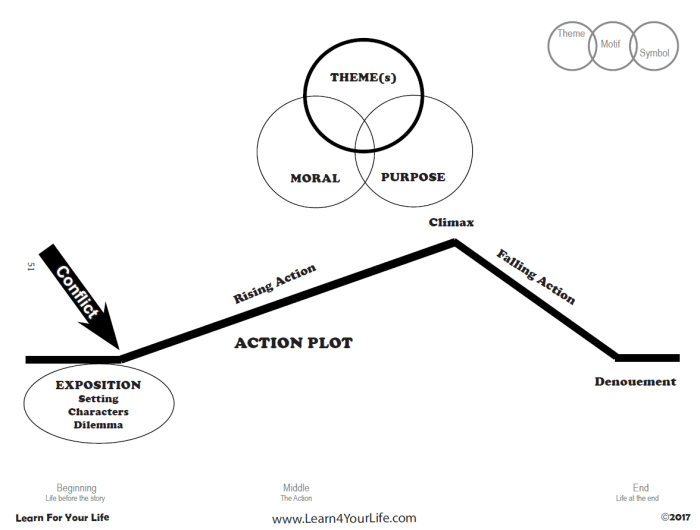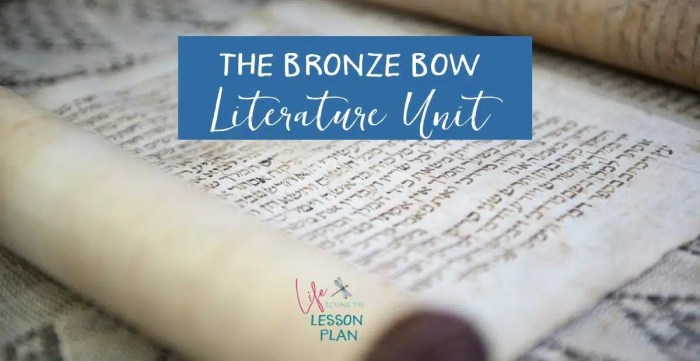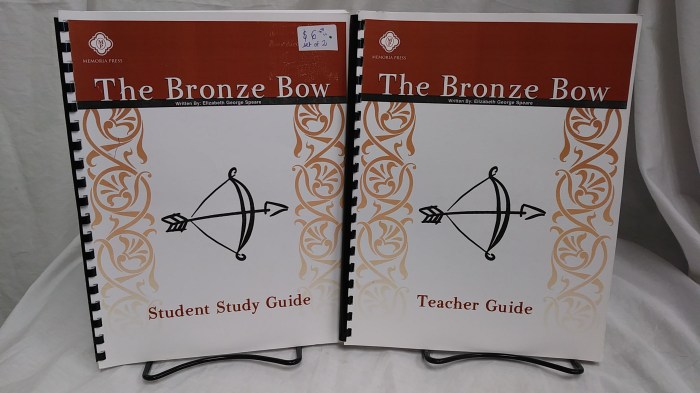Unveiling The Bronze Bow Ani Chart, an indispensable guide to the complexities of Elizabeth George Speare’s historical masterpiece. This comprehensive resource offers an engaging exploration of the novel’s characters, themes, and historical context, providing a deeper understanding and appreciation for this timeless work of literature.
Prepare to delve into a rich tapestry of historical and literary insights, unraveling the intricate threads that weave together the captivating narrative of The Bronze Bow.
The Bronze Bow: Historical Context
Set against the backdrop of Roman-occupied Judea, The Bronze Bow immerses readers in a tumultuous period of history.
Roman Occupation of Judea
The novel takes place during the Roman Empire’s rule over Judea, which began in 63 BCE. This occupation brought significant political and social changes to the region.
- Political Conflict:The Roman occupation imposed a heavy tax burden and restricted Jewish religious practices, leading to resentment and resistance among the Jewish population.
- Social Conflict:Roman soldiers and Jewish civilians often clashed due to cultural differences and the Roman’s harsh treatment of the Jews.
- Religious Tension:The Romans allowed Jewish religious practices but suppressed any sign of Jewish nationalism or messianic hopes.
Daniel Bar Jamin

Daniel Bar Jamin, the protagonist of The Bronze Bow, is a young Jewish boy living in Roman-occupied Galilee during the first century AD. Daniel’s character undergoes a profound transformation throughout the novel as he struggles with his faith, his identity, and his place in the world.
Personality and Motivations
Daniel is a deeply religious boy, raised in the traditions of his ancestors. He is devout and passionate about his faith, and he believes strongly in the power of God. Daniel is also a compassionate and caring individual, always willing to help those in need.
He is driven by a strong sense of justice and a desire to fight for what he believes in.
While the bronze bow ani chart provides a comprehensive overview of the case, it’s also worth exploring groves v john wunder co for additional insights. This landmark case highlights the importance of protecting Native American religious freedom, a topic that intersects with the broader themes explored in the bronze bow ani chart.
Conflicts
Daniel faces a number of conflicts throughout the novel. One of his primary struggles is his faith. Daniel’s faith is tested by the brutality of the Roman occupation and the persecution of his people. He questions his faith and the existence of God, but ultimately he comes to a renewed understanding of his beliefs.
Daniel also struggles with his identity. He is a Jew living in a Roman-occupied land, and he feels like an outsider in both worlds. He is torn between his loyalty to his people and his desire to live in peace with the Romans.
Transformation and Development
Over the course of the novel, Daniel undergoes a significant transformation. He grows from a naive and idealistic boy into a mature and courageous young man. He learns to fight for what he believes in, even when it means putting himself in danger.
He also comes to a deeper understanding of his faith and his place in the world.
Relationships with Other Characters
Daniel has a number of important relationships with other characters in the novel. One of his closest relationships is with his father, Joseph. Joseph is a wise and loving man who teaches Daniel about the importance of faith and compassion.
Daniel also has a close relationship with his friend, Simon. Simon is a fellow Jew who shares Daniel’s passion for justice and freedom.
The Zealots
The Zealots were a Jewish sect that emerged during the Roman occupation of Judea. They were characterized by their intense religious beliefs and their fervent opposition to Roman rule.
The Zealots believed that God had chosen the Jewish people to be a holy nation, and they saw the Roman occupation as a desecration of their land and a violation of their religious laws. They believed that it was their duty to fight against the Romans and to establish a Jewish state free from foreign rule.
Beliefs and Practices
The Zealots were a diverse group, but they shared some common beliefs and practices.
- They believed that God had chosen the Jewish people to be a holy nation.
- They believed that the Roman occupation was a desecration of their land and a violation of their religious laws.
- They believed that it was their duty to fight against the Romans and to establish a Jewish state free from foreign rule.
- They were willing to use violence to achieve their goals.
Role in the Jewish Resistance
The Zealots played a significant role in the Jewish resistance against Roman rule. They were involved in a number of uprisings, including the Great Revolt of 66-70 CE.
The Zealots were a formidable enemy for the Romans. They were highly motivated and willing to fight to the death. They also had a good understanding of the terrain and were able to use it to their advantage.
Impact on the Story’s Events
The Zealots have a significant impact on the events of The Bronze Bow. They are the ones who kill Daniel’s father, and they are the ones who are responsible for the destruction of his village.
Daniel’s hatred for the Zealots drives him to seek revenge. He joins the Roman army and fights against them. However, he eventually comes to realize that the Zealots are not the only ones who are responsible for the suffering of his people.
The Bronze Bow: Symbolism and Allegory: The Bronze Bow Ani Chart

The bronze bow in the novel serves as a powerful symbol with multiple layers of meaning. It represents the strength and resilience of the Jewish people in their fight against Roman oppression. The bow is also a symbol of Daniel’s personal journey, as he struggles to reconcile his faith with the violence he witnesses and participates in.The
story of The Bronze Bow is rich in allegorical meanings. The characters and events can be interpreted as representing broader themes and ideas. For example, Daniel can be seen as a symbol of the Jewish people, while the Zealots represent the more extreme elements of the Jewish resistance.
The novel also explores the themes of faith, violence, and redemption.The novel’s themes are complex and multifaceted. One of the central themes is the nature of violence and its consequences. The novel explores the ways in which violence can be both destructive and redemptive.
Another major theme is the importance of faith. The novel shows how faith can provide strength and hope in the face of adversity.
Violence and Vengeance
In “The Bronze Bow,” violence and vengeance play a pivotal role, shaping the lives and choices of its characters. The novel explores the ethical complexities surrounding these themes, questioning the consequences of violence and the limits of justice.
Daniel’s Actions
Daniel, the protagonist, grapples with the dilemma of violence and vengeance. Having witnessed the brutal Roman oppression, he is torn between seeking justice for his people and the ethical implications of resorting to violence. His actions, while understandable, raise questions about the morality of retaliation and the potential for violence to perpetuate a cycle of suffering.
Ethical Implications
The novel delves into the ethical implications of Daniel’s actions. It questions the justification of violence as a means of achieving justice, exploring the potential for it to corrupt and dehumanize both the perpetrator and the victim. The novel suggests that vengeance can be a self-destructive path, leading to further violence and perpetuating a cycle of hatred.
Consequences of Violence
The novel portrays the devastating consequences of violence on both individuals and communities. Daniel’s actions not only impact his own life but also those of his loved ones and the people around him. The novel illustrates the far-reaching effects of violence, highlighting its ability to shatter lives and undermine the fabric of society.
Roman Oppression

The Roman Empire’s occupation of Judea brought with it a brutal regime that imposed harsh measures on the Jewish people. These oppressive tactics sought to suppress Jewish resistance and maintain Roman control over the region.
Methods of Roman Oppression
- Taxation:Excessive taxes were levied upon the Jewish population, draining their financial resources and causing widespread poverty.
- Conscription:Jewish men were forced into the Roman army, serving in distant lands and facing harsh conditions.
- Cultural Suppression:Jewish religious practices and customs were restricted, including the prohibition of circumcision and the observance of the Sabbath.
li> Violence and Punishment:The Roman army used brutal force to quell Jewish uprisings, crucifying rebels and destroying villages.
Impact of Roman Rule
Roman oppression had a devastating impact on the Jewish people. It eroded their economy, disrupted their social fabric, and threatened their cultural identity. The constant threat of violence and persecution created a climate of fear and resentment among the Jewish population.
Portrayal of Roman Authority
The novel “The Bronze Bow” vividly portrays the oppressive nature of Roman rule. The Roman governor, Pontius Pilate, is depicted as a ruthless and arrogant figure who cares little for the well-being of the Jewish people. His soldiers are portrayed as brutal and unfeeling, enforcing Roman authority with an iron fist.
Redemption and Forgiveness
The Bronze Bow explores the transformative power of redemption and the significance of forgiveness and reconciliation. Through the journeys of Daniel and other characters, the novel delves into the complexities of seeking redemption for past actions and the profound impact it can have on individuals and their relationships.
Daniel’s Redemption Arc
- Daniel’s journey begins with a deep sense of guilt and shame over his involvement in the murder of his father. Driven by a thirst for vengeance, he sets out on a path of violence.
- As the story progresses, Daniel’s encounters with Jesus and other characters challenge his beliefs and lead him to question his actions. He grapples with the consequences of his past and the possibility of redemption.
- Through acts of compassion and forgiveness, Daniel gradually finds a way to reconcile with his past and embrace a new path. His redemption arc highlights the transformative power of forgiveness and the ability to break free from the cycle of violence.
The Importance of Forgiveness and Reconciliation
The novel emphasizes the crucial role of forgiveness and reconciliation in healing wounds and fostering reconciliation. Forgiveness is portrayed not as a sign of weakness but as a powerful force that can liberate individuals from the burden of the past.
- Daniel’s journey illustrates how forgiveness can break the cycle of violence and hatred. By forgiving those who wronged him, he is able to find peace and move forward with his life.
- The novel also explores the importance of reconciliation between individuals and communities. The characters learn that true reconciliation requires not only forgiveness but also understanding, empathy, and a willingness to work together to build a better future.
Love and Relationships: Amidst Conflict
Love and relationships are central themes in The Bronze Bow. The novel explores the different types of love, the challenges and complexities of love during times of conflict, and the impact of love on characters’ decisions and actions.
The most prominent love relationship in the novel is that between Daniel and Leah. Daniel is a young Jewish rebel fighting against the Roman occupation of Judea, while Leah is a young Christian woman who is trying to stay out of the conflict.
Despite their different backgrounds and beliefs, Daniel and Leah fall deeply in love. Their love is a source of strength and comfort for them both, but it also presents them with a number of challenges. They must find a way to reconcile their different beliefs, and they must also deal with the disapproval of their families and communities.
Another important love relationship in the novel is that between Daniel and his brother, Boaz. Boaz is a more cautious and pragmatic man than Daniel, and he does not share his brother’s revolutionary zeal. However, Boaz loves Daniel deeply, and he is willing to risk his own life to protect him.
The relationship between Daniel and Boaz is a reminder that love can exist even between people who have very different beliefs and values.
Love and Conflict
The Bronze Bow shows how love can be a source of strength and hope in times of conflict. Daniel and Leah’s love helps them to cope with the horrors of war, and it gives them the strength to fight for a better future.
However, the novel also shows how love can be a source of pain and sorrow. Daniel and Leah’s love is ultimately doomed, and Boaz is killed in the fighting. The novel suggests that love is always worth fighting for, but it also acknowledges that love can sometimes be lost.
Love and Redemption
The Bronze Bow also explores the theme of love and redemption. Daniel is a flawed character, and he makes many mistakes. However, he is ultimately redeemed by his love for Leah and his desire to make amends for his past actions.
The novel suggests that love can be a powerful force for good, and that it can help people to change and grow.
The Role of Women: Strength and Resilience
In The Bronze Bow, women play significant roles that contribute to the story’s development. They exhibit strength, resilience, and determination in the face of oppression and adversity.
Female Characters and Their Roles
- Leah: The protagonist’s mother, a strong and loving woman who supports her family and community. She is a skilled healer and a source of comfort during troubled times.
- Mary: A young woman who becomes a close friend and confidante of Daniel. She is intelligent, compassionate, and a voice of reason during the conflict.
- Claudia: A Roman woman who befriends Leah and Daniel. She provides a different perspective on the Roman occupation and challenges the prejudices of her society.
- Judith: A wealthy Jewish widow who supports the Zealots. She is a fierce advocate for her people and uses her resources to help the cause.
Cultural Identity and Resistance
The Bronze Bow is set against the backdrop of the Roman occupation of Judea, a period of significant cultural conflict between the Jewish and Roman characters. These differences played a significant role in shaping the narrative and fueling the conflict.
Jewish Identity
The Jewish characters in the novel are deeply rooted in their faith and traditions. They observe the Mosaic Law, celebrate Jewish holidays, and speak Aramaic. Their cultural identity is closely tied to their religious beliefs and practices.
Roman Identity, The bronze bow ani chart
The Roman characters, on the other hand, represent the dominant culture of the time. They are pagans who worship a pantheon of gods and goddesses. They speak Latin and are governed by Roman law. Their cultural identity is based on their military prowess and imperial authority.
Conflict and Resistance
The cultural differences between the Jewish and Roman characters lead to a clash of values and beliefs. The Jews resent the Roman occupation and their attempts to impose their culture on them. They engage in acts of resistance, such as refusing to pay taxes, hiding weapons, and attacking Roman soldiers.
The novel explores the complexities of cultural identity and resistance. It shows how cultural differences can lead to conflict and violence, but it also highlights the importance of preserving one’s cultural heritage and fighting for one’s freedom.
Questions and Answers
What is the significance of the bronze bow in the novel?
The bronze bow serves as a potent symbol of resistance, defiance, and the struggle for freedom against oppression.
How does Daniel’s character evolve throughout the novel?
Daniel undergoes a profound transformation, grappling with the complexities of violence, forgiveness, and the search for redemption.
What are the key themes explored in The Bronze Bow?
The novel delves into themes of identity, cultural conflict, the ethics of violence, and the power of love amidst adversity.
